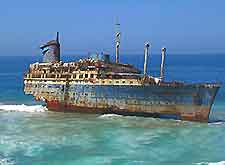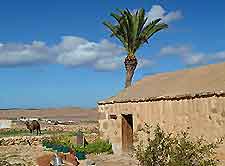Fuerteventura History Facts and Timeline
(Fuerteventura, Canary Islands, Spain)

Fuerteventura is one of the largest of the Canary Islands, a Spanish colony located off the coast of North Africa. In fact, the earliest settlers made the journey here from North Africa and were known for their 'mahos', a traditional shoe made from cured goatskins. To this day, the residents of the island are still known as 'Mahos'.
Recent excavations have found tools and relics in the cave-dwellings belonging to these earliest settlers. However, the history of Fuerteventura truly begins in the 11th century BC, with the arrival of the Phoenicians.
Conquest of the Island
The earliest expeditions from
Portugal and Spain landed on Fuerteventura in the year of 1340, when these explorers left behind a number of European slaves. When the conquest eventually started in the early years of the 15th century, the island had already been divided by a lengthy stone wall known as Erbania. Parts of this wall remain to this day and, in fact, Erbania was one of the earliest names for the island itself. Each side of the wall was a separate kingdom inhabited by a distinct island tribal group.
The first invaders were led by the French explorer Jean de Béthencourt, who was accompanied by fellow crusader, Gadifer de la Salle. By 1404, with the Castilian king's support, they had established Fuerteventura's first capital, Betancuria, which remained the capital right up until 1859. When the territory became a subject of the Catholic Monarchs in 1476, Betancuria served as the island's religious centre. Present-day visitors can still visit Betancuria Church.

The Colonial Era
In 1708, Fuerteventura fell under military rule, headed by the 'Governor at Arms'. The title Governor at Arms was a hereditary one, passed down through the powerful family of the Sánchez-Dumpiérrez. This family only got more powerful during the remainder of the century, as it allied itself with Arias de Saavedra and her family. Of interest, Arias de Saavedra was known as the 'Lady of Fuerteventura'.
Fuerteventura was subject to regular pirate attacks during colonial times and, as a result, a number of fortifications and lookouts were erected all along the shoreline. One of the best-known is the castle at Caleta de Fuste, the island's biggest resort. Completed in 1743, the castle now dominates the resort's harbour and Caleta del Fuste remains known to many as simply, 'El Castillo'.
Self Government
Military rule lasted until the year of 1859, after Isabella II had sanctioned a free-trade area which covered the Canary Islands some seven years earlier. The capital was subsequently moved to Puerto del Rosario and in 1863, a lawyer named Manuel Velázquez Cabrera successfully established the island's earliest council. In 1912, for the first time in its history, Fuerteventura was officially allowed to self-govern and, consequently, Cabrera is now remembered by a statue on the island.
Tourism on the Island Today
The island got its first airport in the 1940s, but the real turning point in Fuerteventura history was when the current airport, El Mattoral, opened at the end of the 1960s. The completion of the airport coincided with the construction of the island's new hotels aimed at the burgeoning package tourist market.
Since then, Fuerteventura has gone from strength to strength, becoming a popular destination among families, surfers and backpackers.
 Fuerteventura is one of the largest of the Canary Islands, a Spanish colony located off the coast of North Africa. In fact, the earliest settlers made the journey here from North Africa and were known for their 'mahos', a traditional shoe made from cured goatskins. To this day, the residents of the island are still known as 'Mahos'.
Fuerteventura is one of the largest of the Canary Islands, a Spanish colony located off the coast of North Africa. In fact, the earliest settlers made the journey here from North Africa and were known for their 'mahos', a traditional shoe made from cured goatskins. To this day, the residents of the island are still known as 'Mahos'.